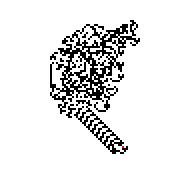Extended Langton's ant
The extended Langton's ant is a mathematical equation for Langton's ant. Langton's ant was invented by Chris Langton in 1986 and runs on a square lattice of black and white cells.[1] The universality of Langton's ant was proven in 2000. the lattice has been wrapped on a one dimensional torus to create a bounded surface for the ant to explore using the following rules


Octave script[edit]
%;*******************************************************************************
%;* Last edited date: 1st June 2016 Ver 1.0
%;*
%;* m-file for langtons ant (closed form)
%;*
%;* Written by: Graham Medland
%;* gmail.com: graham.medland@
%;*******************************************************************************
E=256 % Size of lattice.
N=12288 % Number of iterations.
z(1:1:E^2)=-1;
k(1:1:E^2)=0;
k(1)=(E^2+E)/2;
for t=1:1:N;
k(t+1)=mod(k(t)+real(round((0.5*(E+1)*exp(i*pi/4*(trace(diag(z))-E^2)))-(0.5*(E-1)*exp(-i*pi/4*(trace(diag(z))-E^2)))))+imag(round((0.5*(E+1)*exp(i*pi/4*(trace(diag(z))-E^2)))-(0.5*(E-1)*exp(-i*pi/4*(trace(diag(z))-E^2))))),E^2);
z(k(t+1)+1)=real(exp(2*i*pi/4*(1+z(k(t+1)+1))));
endfor;
figure(1)
surf(reshape(z,E,E))
Wave equation[edit]

Mapping the ant world to a one dimensional flat torus or manifold using Eulers identity,
This can now be recast using partial fractions into the form.
With variables.
- this represents the orthogonal changes in direction (Electric / Magnetic field lines).
- and be the complex conjugates of and
- and where the length of one side of the lattice.
- and is the basis vector for the z axis, the same principle applies to the other two axis.
We create the TWO state oscillator (which gives rise to the discrete L/R rotations depending on the colour of the square), substituting we get,
Note: ( t | t+1 ) means the current index t is using a future statespace evaluated after a rotation has taken place. Now we create the rotate equation, using the sum over all paths integral, see Feynman chessboard since the ant visits all of the squares over time.
Noting that
- If and only if, the entire state space is initialised with element values of +/- 1 ( i.e. No hysteresis )
And since the continuum is elliptical not circular, there will be two radii so we need two of these circular functions scaled by A and B, thus
Now we make the Quantum rotor equations, the elliptical rotations are inside the brackets and the discrete oscillator is outside.
These rotors (torsion based spinor's) when combined expand to form,
This then becomes a superposition of both rotors where in the limit as t tends to infinity we get an equal spread of both functions. At the start of the iteration process, after four iterations of we get which represents a step change in direction of phase, after another four iterations of we get back to , these 8 steps are represented by a simple sum,
Thus in its native state as a 2x2 SU2 Special Unitary Matrix, we have
- and
The Langtons ant Binary matrix becomes an oscillating spinor (a model for a single subatomic particle), with the matrix increased in size we start to see a complex chaotic system which now models an ensemble of particles (a model for the Higgs field interaction).
Thermodynamics[edit]
The main attractor of langtons ant is the 104 highway, on a bounded surface a new super attractor in the spectra of theta ( sum of the lattice ) emerges and as the size of lattice reaches the limit of infinity the algorithm produces a Gaussian distributed system, where at the start of the algorithm there is a low value of entropy (since all squares are the same colour) after several million iterations half of the squares are now black and the other half are white and the ant reaches a steady state where the sum of all squares become zero, see spectra and bell curve Video
Links[edit]
Visit the VR Gallery or download SPATIAL on the META quest2 and view in 3d.
Matrix equation and m-file
References[edit]
- ↑ Langton, Chris G. (1986). "Studying artificial life with cellular automata". Physica D: Nonlinear Phenomena. 22 (1–3): 120–149. doi:10.1016/0167-2789(86)90237-X. hdl:2027.42/26022.
This article "Extended Langton's ant" is from Wikipedia. The list of its authors can be seen in its historical. Articles copied from Draft Namespace on Wikipedia could be seen on the Draft Namespace of Wikipedia and not main one.


![{\displaystyle \left(n\cos \left[{\frac {\pi }{2}}\left(\theta +{\textbf {z}}_{{\textbf {k}}_{t}}\right)\right]+i\sin \left[{\frac {\pi }{2}}\left(\theta +{\textbf {z}}_{{\textbf {k}}_{t}}\right)\right]:\theta \in [-\pi ,+\pi ]\right)\rightarrow \left[(\Delta x,i\Delta y):\in \mathbb {C} \right]}](https://wikimedia.org/api/rest_v1/media/math/render/svg/1ad5ef68b37d82d2bfa6cfb70ec095f5037e89e7)

























